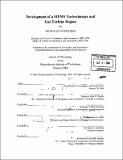Development of a MEMS turbocharger and gas turbine engine
Author(s)
Savoulides, Nicholas, 1978-
DownloadFull printable version (38.75Mb)
Alternative title
Development of a microelectromechanical systems turbocharger and gas turbine engine
Other Contributors
Massachusetts Institute of Technology. Dept. of Aeronautics and Astronautics.
Advisor
Alan H. Epstein.
Terms of use
Metadata
Show full item recordAbstract
As portable electronic devices proliferate (laptops, GPS, radios etc.), the demand for compact energy sources to power them increases. Primary (non-rechargeable) batteries now provide energy densities upwards of 180 W-hr/kg, secondary (rechargeable) batteries offer about 1/2 that level. Hydrocarbon fuels have a chemical energy density of 13,000-14,000 W-hr/kg. A power source using hydrocarbon fuels with an electric power conversion efficiency of order 10% would be revolutionary. This promise has driven the development of the MIT micro gas turbine generator concept. The first engine design measures 23 x 23 x 0.3 mm and is fabricated from single crystal silicon using MEMS micro-fabrication techniques so as to offer the promise of low cost in large production. This thesis describes the development and testing of a MEMS turbocharger. This is a version of a simple cycle, single spool gas turbine engine with compressor and turbine flow paths separated for diagnostic purposes, intended for turbomachinery and rotordynamic development. The turbocharger design described herein was evolved from an earlier, unsuccessful design (Protz 2000) to satisfy rotordynamic and fabrication constraints. The turbochargers consist of a back-to-back centrifugal compressor and radial inflow turbine supported on gas bearings with a design rotating speed of 1.2 Mrpm. This design speed is many times the natural frequency of the radial bearing system. Primarily due to the exacting requirements of the micron scale bearings, these devices have proven very difficult to manufacture to design, with only six near specification units produced over the course of three years. Six proved to be a small number for this development program since these silicon devices are brittle (cont.) and do not survive bearing crashes at speeds much above a few tens of thousands of rpm. The primary focus of this thesis has been the theoretical and empirical determination of strategies for the starting and acceleration of the turbocharger and engine and evolution of the design to that end. Experiments identified phenomena governing rotordynamics, which were compared to model predictions. During these tests, the turbocharger reached 40% design speed (480,000 rpm). Rotordynamics were the limiting factor. The turbomachinery performance was characterized during these experiments. At 40% design speed, the compressor developed a pressure ratio of 1.21 at a flow rate of 0.13 g/s, values in agreement with CFD predictions. At this operating point the turbine pressure ratio was 1.7 with a flow rate of 0.26 g/s resulting in an overall spool efficiency of 19%. To assess ignition strategies for the gas turbine, a lumped parameter model was developed to examine the transient behavior of the engine as dictated by the turbomachinery fluid mechanics, heat transfer, structural deformations from centrifugal and thermal loading and rotordynamics. The model shows that transients are dominated by three time constants - rotor inertial (10⁻¹ sec), rotor thermal (lsec), and static structure thermal (10sec). The model suggests that the engine requires modified bearing dimensions relative to the turbocharger and that it might be necessary to pre-heat the structure prior to ignition ...
Description
Thesis (Ph. D.)--Massachusetts Institute of Technology, Dept. of Aeronautics and Astronautics, 2004. Includes bibliographical references.
Date issued
2004Department
Massachusetts Institute of Technology. Department of Aeronautics and AstronauticsPublisher
Massachusetts Institute of Technology
Keywords
Aeronautics and Astronautics.